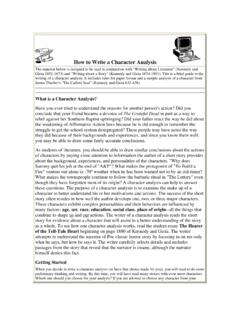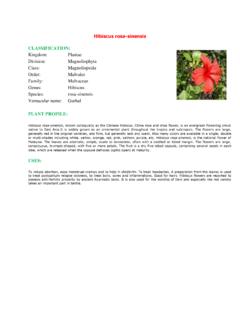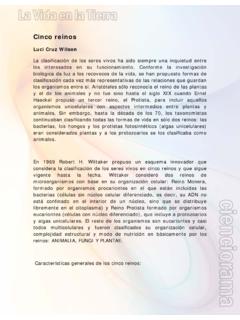Transcription of Lab 4 land plants I - FacultyWeb Support Center | WCJC
1 The Nonvascular plants & Seedless Vascular plants Laboratory 44 Introduction Members of kingdom plantae are all multicellular organisms exhibiting cellulose cell walls, an alternation of generations life cycle and the presence of photosynthetic pigments such as chlorophyll. As photosynthetic autotrophs, plants use solar energy to produce organic compounds from carbon dioxide and water. The plant kingdom consists of four major groups: the nonvascular plants , the seedless vascular plants , the gymnosperms and the angiosperms. The nonvascular plants , such as mosses and liverworts, are one of the simplest groups of the true plants .
2 Considered the earliest transitional terrestrial plants , these species exhibit close evolutionary ties to the green algae. Lacking specialized vascular (transport) tissues (xylem and phloem), these plants are dependent upon diffusion and osmosis for the movement of water and minerals, consequently restricting their ecological distribution to moist environments. Also, without an extensive means of internal transport, nonvasculars lack true roots, stems or leaves and tend to be small, inconspicuous plants . Finally, these plants are gametophyte dominant, meaning that the recognizable stage of these plants is the haploid gametophyte generation.
3 The seedless vascular plants , which include ferns and fern allies, possess several adaptations lacking in nonvascular plants . Xylem and phloem are present to efficiently transport water and sugars, respectively throughout the plant body. Additionally these vascular tissues provide strength and Support , allowing the plants to grow tall and upright. With the presence of vascular tissues, all ferns and fern allies have true stems with most having true roots and leaves. As is true of all vascular plants , the seedless vascular plants are sporophyte dominant, with the recognizable stage being the diploid sporophyte generation.
4 This lab will consider three phyla of Kingdom plantae : Kingdom plantae Nonvascular plants Phylum Bryophyta - mosses Phylum Hepatophyta - liverworts Seedless Vasculars plants Phylum Pterophyta - ferns 1 Alternation of Generations The alternation of generations can be described as the plant possessing two stages during its life cycle, alternating between a multicellular.
5 Diploid (2n) stage and a multicellular, haploid (1n) stage. The diploid plant is called the sporophyte, meaning "spore-producing plant". The sporophyte generation produces a sporangium which contains the diploid spore mother cells that will undergo meiosis to form haploid spores. These released spores will, under the correct environmental conditions, germinate and grow mitotically into the haploid gametophyte. The gametophyte is the "gamete-producing plant" that produces male reproductive structures called antheridia, which produce sperm, and female reproductive structures called archegonia, which produce eggs.
6 When a sperm cell fertilizes an egg inside the archegonium, a diploid zygote is formed. The zygote divides by mitosis and eventually develops into a mature sporophyte. Study tip: You should be familiar with the characteristics of the nonvascular plants , the seedless vascular plants as well as the alternation of generations. 2 STATION 1A: Phylum Bryophyta Phylum Bryophyta: Mosses All bryophytes begin life as a haploid spore. As the spore germinates, it develops into a thin, filamentous stage called a protonema. As the protonema grows, it develops into a mature gametophyte with root-like rhizoids that anchor the plant and an erect, stem-like structure with whorls of leaf-like photosynthetic tissues.
7 At the tops of the gametophytes are haploid reproductive structures surrounded by protective tissues called sterile jackets. Some of these apical structures develop into male antheridia, elongated pod-like structures that produce sperm. Other apical ends develop into clusters of female archegonia, each containing an egg. Dependent upon water for fertilization, flagellated sperm are transported to the archegonia by raindrops or a film of dew. The sperm cell swims into the archegonium and fertilizes the egg, resulting in a diploid zygote within the haploid archegonium.
8 The zygote grows by mitosis into a multicellular, mature moss sporophyte. As the sporophyte develops from the female gametophyte, it remains attached and is nutritionally dependent upon the gametophyte during its existence. The base of the sporophyte is anchored inside the archegonium by the foot with the seta, or stalk, terminating in a capsule containing diploid spore mother cells. Once spore mother cells have undergone meiosis, the capsule pops open scattering the haploid spores. Spores landing in an appropriate environment will germinate and grow into new protonema and eventually into leafy green gametophytes.
9 A. Using the laminated keys provided, label the life cycle of the moss: spores, protonema, gametophyte, rhizoids, antheridia, archegonia, sporophyte (foot, seta, capsule), meiosis, fertilization, haploid, diploid 3B. Observe the moss specimens provided. 1) Examine a moss gametophyte. Note the whorls of leaf-like photosynthetic tissue. 2) Examine a moss sporophyte. Identify the foot, seta and capsule. C. Examine prepared slide of moss archegonia. Note the location of the egg and the upright orientation of the vase-shaped archegonia.
10 Sketch your observations below. D. Examine prepared slide of moss antheridia. Note the numerous, sac-like antheridia. Sketch your observations below. Moss archegonia Moss antheridia (high power) (high power) Questions: 1. What is the dominant generation of a moss? Is this generation haploid or diploid? 2. What process occurs inside the capsule to produce spores? 3. What role does water play in the reproductive life cycles of nonvascular plants ? 4.







